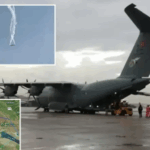Summary by Geopolist | Istanbul Center for Geopolitics:
China’s recent actions in Bhutan highlight an ongoing strategic maneuver that has significant geopolitical implications. Over the past eight years, China has built 22 villages on Bhutanese territory, annexing approximately 2% of Bhutan’s land. The primary area of focus is the Doklam plateau, which holds strategic value in China’s border disputes with India. Additionally, China’s expansion into northeastern Bhutan appears to be a tactic to pressure Bhutan into a territorial settlement favorable to Beijing. Despite a 1998 treaty pledging non-aggression, China’s actions demonstrate a hard-power approach that parallels its activities in the South China Sea.
The establishment of villages and settlements within Bhutanese borders, particularly in the western Doklam region and northeastern areas such as Beyul Khenpajong and Menchuma, indicates a calculated initiative by China to bolster its territorial assertions. The Doklam plateau holds notable military importance because of its closeness to India’s Siliguri Corridor, a narrow and strategically crucial area of land. By exerting control over certain areas of this region, China could strengthen its strategic position regarding India, with which it has persistent border disputes.
Conversely, China’s manoeuvres in northeastern Bhutan—an area that does not possess clear strategic importance—serve mainly as a means of diplomatic pressure. During the 1980s and 1990s, China put forward a “package deal,” suggesting that it would relinquish its claims in the northeast in exchange for Bhutan ceding portions of its western territory, including Doklam. Through the establishment of villages in these northeastern regions, China has skillfully leveraged the fear of territorial loss to compel Bhutan into making concessions in its western sector. The gradual shift of these regions from Bhutanese to Chinese control, accompanied by a lack of substantial international response, underscores China’s strategic methodology.
The importance of China’s actions in Bhutan extends beyond mere territorial expansion. This indicates a wider pattern in China’s foreign policy, where smaller neighbouring countries are influenced through gradual, non-aggressive strategies that reinforce advantages progressively. Comparable tactics have been noted in the South China Sea, where China has constructed artificial islands and military facilities to reinforce its territorial assertions. In Bhutan, these actions represent a blend of military positioning, diplomatic leverage, and the establishment of “facts on the ground” that reinforce China’s presence without engaging in direct conflict.
The situation in Bhutan is delicate. The small size and limited resources of Bhutan create challenges in addressing China’s actions, particularly due to Bhutan’s dependence on India for security. Nevertheless, the 2007 India-Bhutan treaty complicates Bhutan’s capacity to engage independently with China, as India’s consent is required for any territorial concessions that may impact its security. Consequently, Bhutan finds itself in a challenging position between two influential neighbors—China, which is pushing for territorial concessions, and India, whose security concerns limit Bhutan’s ability to engage in diplomatic negotiations.
The actions of China in Bhutan bring forth considerable apprehension regarding the future of territorial disputes across Asia. Through a combination of military, diplomatic, and economic pressure, China is establishing a model for its interactions with smaller neighbouring countries moving forward. The lack of substantial international response or intervention regarding China’s annexation of Bhutanese territory may encourage additional expansionist actions in the region, especially in disputed areas along China’s borders.
In summary, China’s land appropriation in Bhutan represents a strategic manoeuvre that further enhances its military and diplomatic objectives. The continuous development of villages within Bhutanese territory, along with diplomatic pressure, illustrates China’s wider approach of employing territorial expansion to secure strategic benefits while avoiding direct confrontation. This situation highlights the difficulties encountered by small states navigating the influence of dominant neighbours, while also prompting the international community to consider how to address territorial encroachment by significant powers such as China.
Read the full article here.







